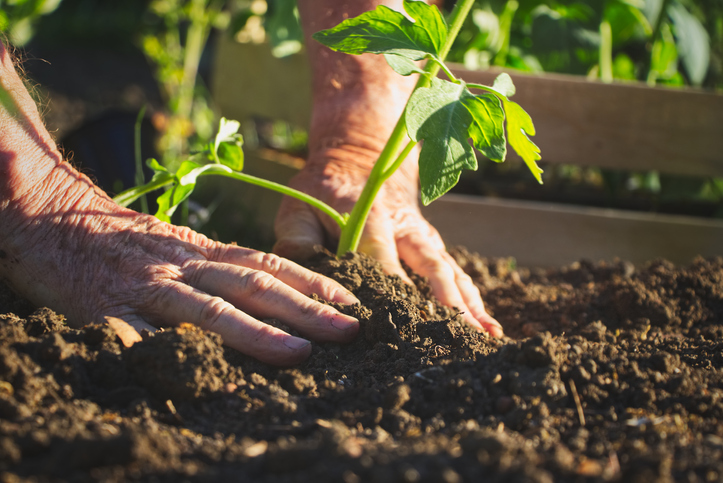
One of the best decisions I ever made was to eliminate the water hogging lawn around my home and grow food instead. I started small in the backyard in 2012 which then evolved to a front yard edible landscape too. My front yard gardening project surely raised some eyebrows (especially since I live right next to our neighborhood elementary school with the usual traffic if it wasn’t for COVID), but I also got quite some support and followers, inspiring others to do the same and put the vegetables on display.
Dream big but start small. All you really need to get started is some decent soil and a few plants. But before you go and buy some spontaneous items at your nearest nursery, I recommend you get informed: ask friends and neighbors who are growing food how they got started, then tour their gardens or veggie patches. Check the library and your local nursery for books, flyers, and vegetable workshops or talks; check your city’s website for resources (usually they have a composting chapter) or look for the Master Gardeners’ resources in your area. Ask in your neighborhood (on platforms like Nextdoor) whether others have started growing food. Having at least one “mentor” for this new hobby gives you some hands-on guidance. They usually know where to get the healthiest plants and soil and can point you to other growers whose gardens you can tour. Check Pinterest for inspiration on vegetable gardens big and small; you will be surprised at what kind of containers people grow vegetables – like old bed frames! Get creative!
You can grow food in even the smallest spaces, containers, pots on the balcony, or on a small patio. Look into Geo-pots or grow bags. These usually come in sets of 4-6 and have the huge advantage of being portable! So, if you are in a rental space and you need to move during the summer, those delicious tomatoes can move with you.
Challenged for space? No problem! Think pots and window sills. A few herbs from pots on a window sill can add so much flavor and vibrancy to your cooking.
Raised beds make efficient use of space and keep maintenance to a minimum. They are a good option for beginners because they make the garden more manageable. Landscape companies usually offer their services to build custom-made vegetable beds, but there are also many different do-it-yourself kits. Check Home Depot, the nurseries, even Amazon. If you are talented with your building skills, you can get really inspired by ideas on Pinterest, Instagram, YouTube and online forums. For not so handy people, there are plenty of options to find variously priced, raised beds online. (If you need some help here in the Bay Area, I can put you in touch with two builders).
Feed the soil! You obviously need a great quality medium to grow your vegetables. Usually, larger quantities of soil can be delivered by gardening companies. Make sure the soil is organic. Composting is one way to get organic matters around your veggie plants. Organic matter is by far the most useful substance for building and maintaining a healthy, well-balanced soil. You can add organic matter to your soil many different ways, such as compost, shredded leaves, cover crops (like mustard greens), but also by having a traditional compost bin or a worm compost bin. Vermicomposting processes your organic kitchen waste into fantastic compost and worm tea – fast. It is also called the organic garbage disposal (and makes a great science project for school).
Do not buy into the myth that “growing veggies” is too water-costly. Nothing could be further from the truth. Just think about the cost of watering your lawn or the overall cost of growing fruits and vegetables in Mexico or even farther away. Those crops are sprayed intensely with water in the fields, then shipped to your supermarket, then into your kitchen. Get my point? With a carefully installed drip system or thorough hand watering, the plants will get just as much as they need. No waste of water or resources.
Check whether you have access to a community garden or company vegetable garden.
You can save money at the grocery store. Growing your own food is like printing your own money! Inquire if the water company will rebate money if you remove some lawn space.
A few other facts that might get you into growing mood:
Food grown at home is the healthiest food on earth. You’ll get the best, nutrients – vitamins & minerals – that your body needs to thrive! Immunity is crucial during these challenging times, and not only do you expose yourself to all the microorganisms during your gardening sessions, but your home grown food includes zinc, vitamin c, and of course vitamin D! Gardening is great outdoor exercise!
You’ll get superior flavor. The food ripens right outside your door. Nothing tastes like a homegrown tomato. And.. if kids grow a tomato, kids will eat a tomato!
Growing your own food brings inner peace and a sense of pride. Watching a garden grow is good for the soul.
From balcony-to-table, yard-to-table, pot-to-table. Get creative!
One of my visions for 2021 is (since I couldn’t do it last year) to run a neighborhood community event in my driveway – neighbors bring the extras of their gardens (I see many peaches, lemons, oranges rot because they are not picked) and take whatever they can use in their kitchens. Don’t have something from your garden to share? No problem! Neighbors can bring coffee or lemonade or offer their time to help with household chores. Gardening (and sharing the benefits!) brings people together and helps to keep the food system local.
Resources: Documentary “The Need to Grow”
Watch this 10 min TED Talk with Ron Finley, the “Guerilla Gardener” and you will want to get started right away!
Yamagami’s Nursery in Cupertino, CA
“To plant a garden is to believe in tomorrow.” (Audrey Hepburn)
“Gardening is cheaper than therapy… and you get tomatoes.” (Unknown)


